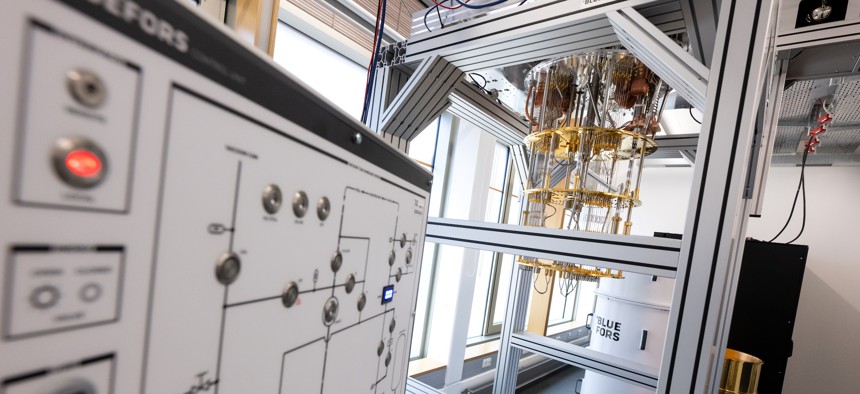
A quantum computer at the Leibniz Computing Center in Germany Sven Hoppe/Getty Images
NIST's new quantum switch aims to smooth path toward a functional computer
No one knows just how to build a useful quantum computer, but the agency is working on devices that may help.
Researchers affiliated with the National Institute of Standards and Technology unveiled a new device last week that aims to cut down the “noise” generated by quantum computing systems’ information processing, part of a larger agency agenda to meet private sector innovation in the quantum information science and technology field.
The device, a programmable switch that can improve connectivity between two qubits, or quantum units of information, was initially introduced in a research paper. One of the authors, NIST physicist Ray Simmonds, told Nextgov/FCW that with these devices, NIST aims to enable future advances in quantum computing infrastructure.
“NIST is trying to…say, ‘what do we need to do to make that technology happen?’” he said. “Right now, Google and IBM have been working on scaling something up, and they're using a technology that can work on a larger scale…but it's not going to have all the functionality you need necessarily to make a robust machine at this point. There's other things that have to get sorted.”
Making a strong switch between these qubits to help them perform calculations and other operations more accurately is one of those external components key to emerging QIST architectures.
“What we've been doing is to try to push the envelope and say, ‘Can we make a system where all these individual elements can be turned on and off?’” he said.
As quantum computing is still an emerging technology field — where universally operable quantum computers are an estimated decade away — experts are uncertain as to the exact system architecture it will require.
Devices like NIST’s switch intend to promote a level of flexibility in operating a future quantum computer, especially as the field continues to evolve.
“We feel like this is the kind of thing that's going to need to happen if you want to make a machine that's more flexible, and to push to the next level to make it have more connections and have more ways of of operating the device,” Simmonds said. ”We don't know exactly what is the best architecture to make a quantum machine yet.”
The toggle tackles a fundamental element required for precise quantum computing — noise reduction between qubits — but also can turn on the measurement of both qubits simultaneously, a feature that can help reduce quantum computational errors.
“One of NIST’s missions is to not only figure out how to measure things better but more efficiently and with higher fidelity; and making those measurements better but figuring out what are the next measurements that need to happen to enable technologies,” Simmonds said.
He added that as technologies continue to advance, specific measurements and standards applicable to them will change. In this vein, NIST is “really trying to push the whole U.S. forward and help bring those new ideas to bear,” he said.




